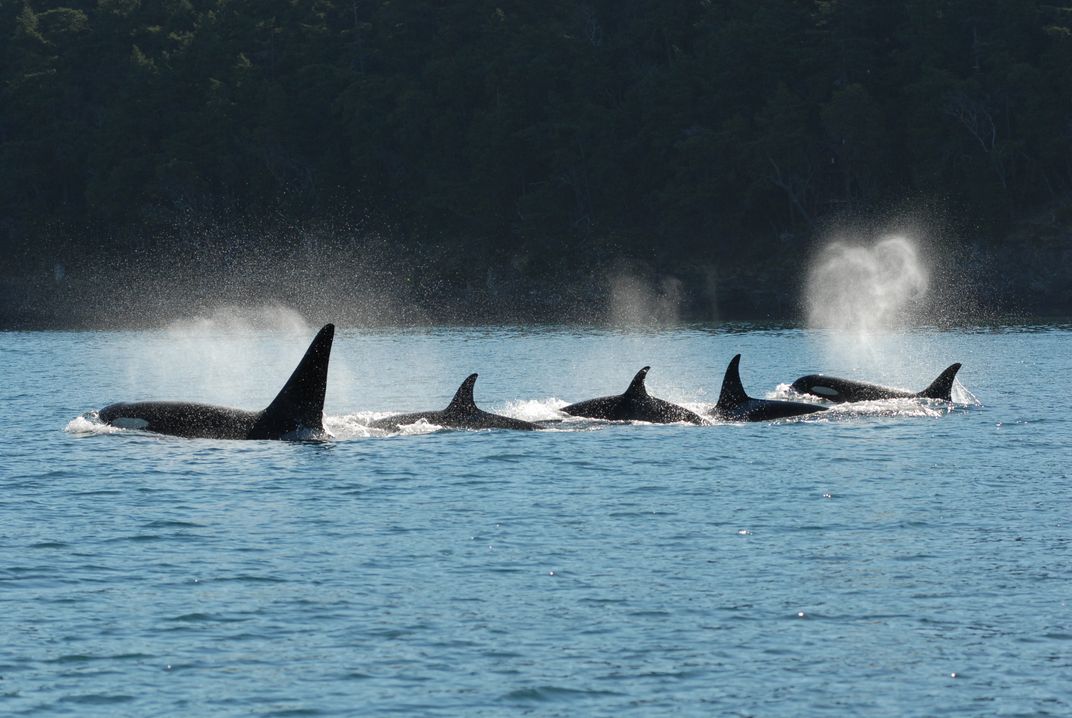After Menopause, Killer Whale Moms Become Pod Leaders
When their reproductive years are done, females take on new roles as wise survival guides
/https://tf-cmsv2-smithsonianmag-media.s3.amazonaws.com/filer/21/90/21902828-0f6e-49b7-ac7f-dc74ad7c6432/42-33052272.jpg)
As one of only a handful of animals on the planet to live many years after menopause, killer whales have just provided new insight into the benefits of this seemingly strange reproductive strategy. Females that are past their child-bearing years go on to become group leaders with valuable survival skills, scientists report today in the journal Current Biology.
Theoretically, menopause should not exist. If the purpose of survival is reproduction, then there is no reason for an animal to stay alive when it can no longer have offspring. For killer whales, females stop reproducing at around 50 years old, which is also the age when most male killer whales are nearing the ends of their lives. Typically, though, post-menopausal females still have another 40 years to go.
Scientists from the University of Exeter, the University of York and the Center for Whale Research examined 35 years’ worth of observational data from an endangered population of southern resident killer whales in the Pacific Northwest. They pored over decades’ worth of photographs capturing whales on the move and noticed a pattern: Post-menopausal females, the oldest in the group, typically swam at the front and directed their pods’ movements in a variety of scenarios. To explain this behavior, the team focused their dataset to years when killer whales’ primary food supply, salmon, was critically low.
"One way post-reproductive females may boost the survival of their kin is through the transfer of ecological knowledge,” says Lauren Brent of the University of Exeter. “The value gained from the wisdom of elders can help explain why female killer whales and humans continue to live long after they have stopped reproducing."
While some transient populations of killer whales famously prey on seals, resident killer whales stay in one place, depending on annual salmon runs in their established territories. Within the Pacific Northwest group, the animals mostly eat chum salmon, which makes up more than 90 percent of their diet. In such a specialized environment, the ability to find fish becomes invaluable to the whales’ survival and reproductive success. And when the salmon are in short supply, only killer whales with years of hunting experience know how to find them.
During these rough times, the researchers saw that post-reproductive females would swim at the heads of hunting groups with young male whales in close pursuit. They were almost always the matriarch’s sons.

“Killer whale mothers direct more help toward sons than daughters, because sons offer greater potential benefits for her to pass on her genes,” explains Daniel Franks of the University of York. “Sons have higher reproductive potential and they mate outside the group, thus their offspring are born into another group and do not compete for resources.”
Whether these bachelors recognize their mothers as wise sages is unclear, but each young male will stay by his mother’s side as long as she lives. With her offspring sticking around, killer whales enjoy perhaps even greater opportunities than human mothers to invest in their offspring's welfare through a variety of social and biological means. Some of the behaviors she displays, such as food sharing and social guidance, have also been documented among menopausal women in hunter-gatherer groups.
“In humans, it has been suggested that menopause is simply an artifact of modern medicine and improved living conditions," says Darren Croft of the University of Exeter. “However, there is mounting evidence suggesting that menopause in humans is adaptive.”
Some of that evidence may very well come from the sea. While menopause leaves no traces in the fossils of our ancestors, its social function among killer whales presents a modern-day opportunity for deciphering how it evolved in preliterate human society, when knowledge was still transferred through word-of-mouth. Only for killer whales, which communicate using a fatty organ in their foreheads, it’s word-of-melon.